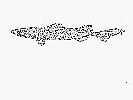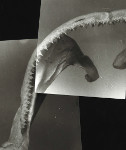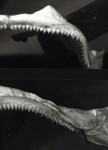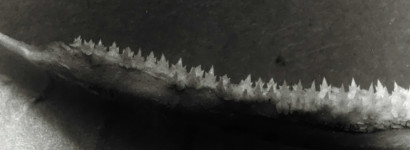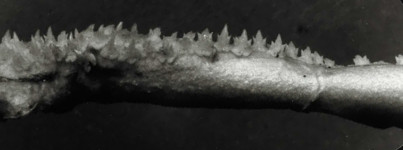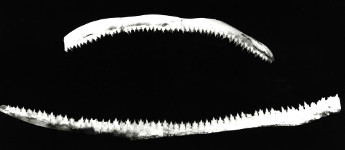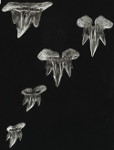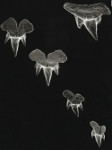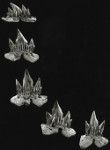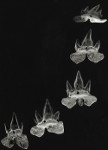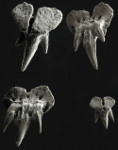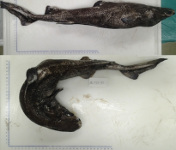Centroscyllium fabricii
(Reinhardt, 1825)
Black dogfish
Classification: Elasmobranchii Squaliformes Etmopteridae
Reference of the original description
Ichthyologiske bidrag. In Örsted, H.C. (Ed.). Oversigt over det Kongelige Danske Videnskabernes Selskabs Forhandlinger og dets Medlemmers Arbeider (Kjøbenhavn) 1824–25 (pp. 15–35). A.F. Høst, København
Ichthyologiske bidrag. In Örsted, H.C. (Ed.). Oversigt over det Kongelige Danske Videnskabernes Selskabs Forhandlinger og dets Medlemmers Arbeider (Kjøbenhavn) 1824–25 (pp. 15–35). A.F. Høst, København
Image of the original description
No image in first description.
No image in first description.
Synonyms / new combinations and misspellings
Centroscyllium farbicii, Spinax fabricii
Centroscyllium farbicii, Spinax fabricii
Description :
Citation: Centroscyllium fabricii (Reinhardt, 1825): In: Database of modern sharks, rays and chimaeras, www.shark-references.com, World Wide Web electronic publication, Version 04/2024
Please send your images of "Centroscyllium fabricii" to info@shark-references.com
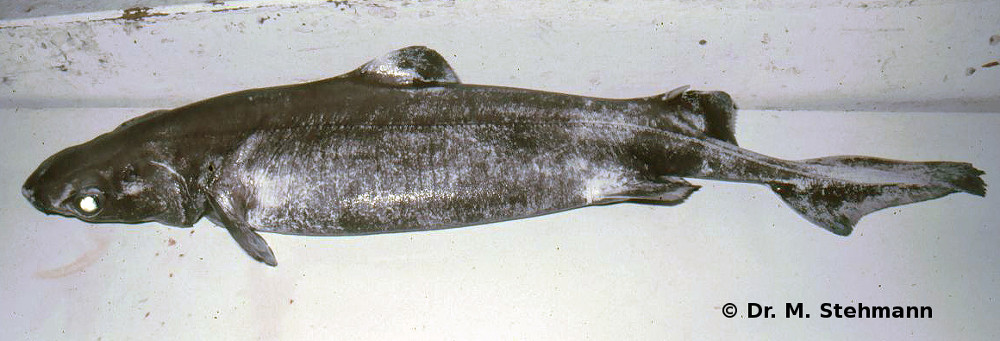
Centroscyllium fabricii (Reinhardt, 1825), female, 1986 WH TIFI 6 © Dr. M. Stehmann

Centroscyllium fabricii (Reinhardt, 1825), female, 1986 WH TIFI 6 © Dr. M. Stehmann
Common names
 Tollo negro,
Tollo negro,  Tollo negro merga,
Tollo negro merga,  Aiguillat noir,
Aiguillat noir,  Black dogfish
Black dogfish
 Tollo negro,
Tollo negro,  Tollo negro merga,
Tollo negro merga,  Aiguillat noir,
Aiguillat noir,  Black dogfish
Black dogfish
Short Description
Original Diagnosis after EBERT & STEHMANN [17836]: Field Marks: No anal fin. First dorsal fin with a low subangular fin web. Two grooved dorsal–fin spines, the first low and the second moderately high. Teeth with narrow cusps and cusplets in both upper and lower jaws. Denticles high, conical and sharp–cusped, dense and numerous on dorsal and ventral surfaces of body; skin firm. Abdomen long, caudal peduncle short. Colour uniform blackish–brown above and below, without white fin markings or discrete black photomarks on body. Diagnostic Features: Preoral snout about 32 to 36% of head length. Mouth moderately arched and about 35 to 38% as long as wide. Body moderately stout and compressed; caudal peduncle short with pelvic–caudal space about 11 to 14% of total length. Teeth similar in upper and lower jaws, with a single large, acutely pointed central cusp, flanked by 1 or 2 lateral cusplets; tooth count from a single individual was 68 (upper jaw) and 68 (lower jaw). Denticles close–set and numerous on body; lateral trunk denticles conical and with sharp hooked cusps. Pectoral–fin apices when laid back ending well anterior to first dorsal–fin spine origin. First dorsal fin low with height about 0.4 times base length, fin semi–elliptical or subtriangular in shape; first dorsal–fin spine short, much lower than second dorsal–fin spine, and ending below first dorsal–fin apex and far anterior to it. Second dorsal fin considerably larger than first dorsal fin; second dorsal–fin spine short to elongated, extending to below or about the height of second dorsal–fin apex but ending far anterior to it; origin of second dorsal–fin spine over or just behind pelvic–fin insertions. Vertebral counts: total vertebral counts 87 to 97, precaudal vertebral counts 60 to 67, monospondylous vertebral counts 43 to 46. Intestinal valve counts 7 to 10. Size moderate, with adults to 107 cm. Colour: blackish brown above and below, without conspicuous black markings on ventral surface or sides of tail; fins without white markings.
Original Diagnosis after EBERT & STEHMANN [17836]: Field Marks: No anal fin. First dorsal fin with a low subangular fin web. Two grooved dorsal–fin spines, the first low and the second moderately high. Teeth with narrow cusps and cusplets in both upper and lower jaws. Denticles high, conical and sharp–cusped, dense and numerous on dorsal and ventral surfaces of body; skin firm. Abdomen long, caudal peduncle short. Colour uniform blackish–brown above and below, without white fin markings or discrete black photomarks on body. Diagnostic Features: Preoral snout about 32 to 36% of head length. Mouth moderately arched and about 35 to 38% as long as wide. Body moderately stout and compressed; caudal peduncle short with pelvic–caudal space about 11 to 14% of total length. Teeth similar in upper and lower jaws, with a single large, acutely pointed central cusp, flanked by 1 or 2 lateral cusplets; tooth count from a single individual was 68 (upper jaw) and 68 (lower jaw). Denticles close–set and numerous on body; lateral trunk denticles conical and with sharp hooked cusps. Pectoral–fin apices when laid back ending well anterior to first dorsal–fin spine origin. First dorsal fin low with height about 0.4 times base length, fin semi–elliptical or subtriangular in shape; first dorsal–fin spine short, much lower than second dorsal–fin spine, and ending below first dorsal–fin apex and far anterior to it. Second dorsal fin considerably larger than first dorsal fin; second dorsal–fin spine short to elongated, extending to below or about the height of second dorsal–fin apex but ending far anterior to it; origin of second dorsal–fin spine over or just behind pelvic–fin insertions. Vertebral counts: total vertebral counts 87 to 97, precaudal vertebral counts 60 to 67, monospondylous vertebral counts 43 to 46. Intestinal valve counts 7 to 10. Size moderate, with adults to 107 cm. Colour: blackish brown above and below, without conspicuous black markings on ventral surface or sides of tail; fins without white markings.
Distribution
Eastern Atlantic: from Iceland along the Atlantic Slope, including the Iceland–Faroe Ridge, to the Faroe Islands, southern Norway, Rockall Trough and Porcupine Seabight to Morocco, Mauritania, Senegal, Guinea, Sierra Leone, Namibia, and South Africa. Western North Atlantic: it occurs from Greenland south to Canada (Baffin Island, Labrador, Newfoundland, and Nova Scotia) and the USA (south to Virginia and possibly North Carolina) and in the northern Gulf of Mexico. Western South Atlantic records from off Argentina (Beagle Channel) should be closely examined to determine whether this or a similar, but different species occurs there [17836]. Source: www.gbif.org
Eastern Atlantic: from Iceland along the Atlantic Slope, including the Iceland–Faroe Ridge, to the Faroe Islands, southern Norway, Rockall Trough and Porcupine Seabight to Morocco, Mauritania, Senegal, Guinea, Sierra Leone, Namibia, and South Africa. Western North Atlantic: it occurs from Greenland south to Canada (Baffin Island, Labrador, Newfoundland, and Nova Scotia) and the USA (south to Virginia and possibly North Carolina) and in the northern Gulf of Mexico. Western South Atlantic records from off Argentina (Beagle Channel) should be closely examined to determine whether this or a similar, but different species occurs there [17836]. Source: www.gbif.org
Human uses
fisheries: subsistence fisheries
fisheries: subsistence fisheries
Biology
Distinct pairing with embrace [17086]. Found on the outermost continental shelves and upper slopes, mostly below 275 m [518]. At high latitudes, may move up to the surface especially during the winter [518]. Bottom water temperature are from 3.5 to 4.5°C, but sometimes down to 1°C. Feeds on crustaceans, cephalopods, jellyfish and small fishes.
Distinct pairing with embrace [17086]. Found on the outermost continental shelves and upper slopes, mostly below 275 m [518]. At high latitudes, may move up to the surface especially during the winter [518]. Bottom water temperature are from 3.5 to 4.5°C, but sometimes down to 1°C. Feeds on crustaceans, cephalopods, jellyfish and small fishes.
Remarks
shark-references Species-ID=1269;
shark-references Species-ID=1269;
Parasites (arranged by Jürgen Pollerspöck)
Cestoda
Copepoda
Thecostraca
- Haemohormidium sp. [21433]
Cestoda
- Gilquinia sp. [20495]
Copepoda
- Neoalbionella centroscyllii (Hansen, 1923) [16606]
- Neoalbionella fabricii (Rubec & Hogans, 1988) [23408]
Thecostraca
- Anelasma sp. [6891]








